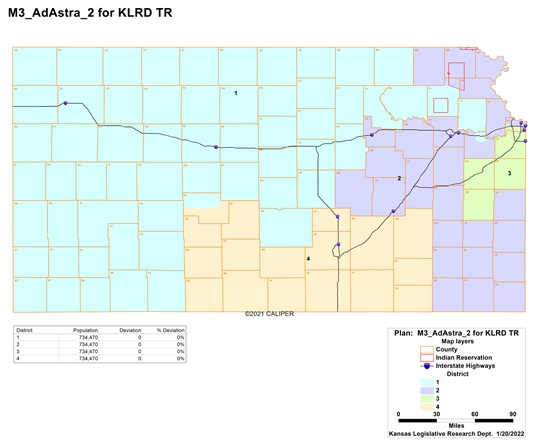The Senate override advances the map to the House. An override in that chamber would put the controversial redistricting plan into state law.
by Stephen Koranda, Kansas News Service and KCUR
A last-ditch effort to override the governor’s veto of a controversial congressional redistricting plan succeeded in the Kansas Senate Tuesday, setting up a high-stakes vote in the House to put the map into law.
The Senate voted to override Democratic Gov. Laura Kelly’s veto of a redistricting plan that critics have said is gerrymandered to hurt Democrats and defeat U.S. Rep. Sharice Davids, the state’s only Democratic member of Congress.
The Senate vote came after the initial vote fell short Monday. Republicans used a procedural move to give them another day and another chance to pressure lawmakers to support the plan.
The 27-11 vote fell along party lines and was the bare minimum needed for an override in the Senate. The override initially failed Monday with 24 votes in favor. Two Republican lawmakers did not vote for or against the bill during the final override effort.
Republican Sen. Alicia Straub from Ellinwood was one of the lawmakers who faced pressure over the last day to switch from opposing to supporting an override. She switched her vote Tuesday.
“This is not about standing with the governor,” Straub said. “This is about standing for freedom.”
Another senator who switched his vote, Republican Mark Steffen from Hutchinson, supported the override while at the same time criticizing the plan because it puts Lawrence in the vast, conservative 1st District of western Kansas.
“They are dumping the Lawrence liberals in our lap,” Steffen said after voting to support an override. “Insidious redistricting will kill off the true conservative character of my beloved Big 1st.”
Steffens’ vote switched just hours after a bill he supported was advanced in the Legislature. A committee voted to support a bill that would limit investigations of physicians who prescribe unproven COVID-19 treatments. It would also allow parents to claim religious exemptions to any vaccine requirement at schools and daycares.
Steffen, a physician, has said in the past that he is under investigation by the state’s regulatory board, the Board of Healing Arts.
“We see what happens when you get 24 hours and you get to make some backroom deals to get your way,” Senate Democratic Leader Dinah Sykes, from Lenexa, said during the vote. “I am disappointed in this chamber.”
Democrats continued to criticize the map Tuesday for the way it divides the state’s congressional districts and splits the racially diverse Democratic stronghold of Wyandotte County.
“This map is a travesty,” Overland Park Democratic Sen. Cindy Holscher said. “When we do things like this, democracy dies a little bit.”
The state Republican Party wasted no time after the initial vote failed Monday, sending out an email alert urging people to call Republican senators who hadn’t supported the override.
“We cannot have Kansas Republicans voting to support Laura Kelly’s agenda,” the email read.
Kelly vetoed the bill because she said it violated redistricting rules by diluting minority votes and breaking apart communities.
“(The map) does not follow these guidelines and provides no justification for deviation from those guidelines,” Kelly said in her veto message last week.
Republicans have argued the changes are needed because of population shifts in the state.
If the House also votes to override the veto, the plan will likely still face a legal challenge.
The proposal draws districts for the state’s four seats in the U.S. House of Representatives. Kansas lawmakers must draw a new map every 10 years to account for population shifts documented in the U.S. Census.
Democrats have blasted the plan because they say it’s aimed at diluting the votes of left-leaning communities and people of color in an effort to defeat the state’s lone Democratic member of Congress.
Rep. Davids, a Democrat, holds the 3rd District seat in the Kansas City area. The plan would split part of Wyandotte County out of the 3rd District and replace it with Republican-leaning rural counties southwest of the Kansas City area.
The map would also move the left-leaning community of Lawrence from the 2nd District into the large, conservative 1st District that stretches west to the Colorado border.
Jim McLean of the Kansas News Service contributed to this report.
Stephen Koranda is the news editor for the Kansas News Service. You can follow him on Twitter @Stephen_Koranda or email him at stephenkoranda (at) kcur (dot) org.
The Kansas News Service is a collaboration of KCUR, Kansas Public Radio, KMUW and High Plains Public Radio focused on health, the social determinants of health and their connection to public policy.
Kansas News Service stories and photos may be republished by news media at no cost with proper attribution and a link to ksnewsservice.org.
See more at https://www.kcur.org/news/2022-02-08/kansas-senate-overrides-the-governors-veto-of-republican-redistricting-plan

